torch& tensorflow
2024-09-08 15:35:51
#torch
import torch
import torch.nn as nn
import torch.nn.functional as F class Net(nn.Module): def __init__(self):
super(Net, self).__init__()
# 1 input image channel, 6 output channels, 5x5 square convolution
# kernel
self.conv1 = nn.Conv2d(1, 6, 5)
self.conv2 = nn.Conv2d(6, 16, 5)
# an affine operation: y = Wx + b
self.fc1 = nn.Linear(16 * 5 * 5, 120)
self.fc2 = nn.Linear(120, 84)
self.fc3 = nn.Linear(84, 10) def forward(self, x):
# Max pooling over a (2, 2) window
x = F.max_pool2d(F.relu(self.conv1(x)), (2, 2))
# If the size is a square you can only specify a single number
x = F.max_pool2d(F.relu(self.conv2(x)), 2)
x = x.view(-1, self.num_flat_features(x))
x = F.relu(self.fc1(x))
x = F.relu(self.fc2(x))
x = self.fc3(x)
return x def num_flat_features(self, x):
size = x.size()[1:] # all dimensions except the batch dimension
num_features = 1
for s in size:
num_features *= s
return num_features net = Net()
print(net) params = list(net.parameters())
print(len(params))
print(params[0].size()) # conv1's .weigh input = torch.randn(1, 1, 32, 32)
out = net(input)
print(out)

vgg
#从keras.model中导入model模块,为函数api搭建网络做准备
from tensorflow.keras import Model
from tensorflow.keras.layers import Flatten,Dense,Dropout,MaxPooling2D,Conv2D,BatchNormalization,Input,ZeroPadding2D,Concatenate
from tensorflow.keras import *
from tensorflow.keras import regularizers #正则化
from tensorflow.keras.optimizers import RMSprop #优化选择器
from tensorflow.keras.layers import AveragePooling2D
from tensorflow.keras.datasets import mnist
import matplotlib.pyplot as plt
import numpy as np
from tensorflow.python.keras.utils import np_utils #数据处理
(X_train,Y_train),(X_test,Y_test)=mnist.load_data()
X_test1=X_test
Y_test1=Y_test
X_train=X_train.reshape(-1,28,28,1).astype("float32")/255.0
X_test=X_test.reshape(-1,28,28,1).astype("float32")/255.0
Y_train=np_utils.to_categorical(Y_train,10)
Y_test=np_utils.to_categorical(Y_test,10)
print(X_train.shape)
print(Y_train.shape)
print(X_train.shape) def vgg16():
x_input = Input((28, 28, 1)) # 输入数据形状28*28*1
# Block 1
x = Conv2D(64, (3, 3), activation='relu', padding='same', name='block1_conv1')(x_input)
x = Conv2D(64, (3, 3), activation='relu', padding='same', name='block1_conv2')(x)
x = MaxPooling2D((2, 2), strides=(2, 2), name='block1_pool')(x) # Block 2
x = Conv2D(128, (3, 3), activation='relu', padding='same', name='block2_conv1')(x)
x = Conv2D(128, (3, 3), activation='relu', padding='same', name='block2_conv2')(x)
x = MaxPooling2D((2, 2), strides=(2, 2), name='block2_pool')(x) # Block 3
x = Conv2D(256, (3, 3), activation='relu', padding='same', name='block3_conv1')(x)
x = Conv2D(256, (3, 3), activation='relu', padding='same', name='block3_conv2')(x)
x = Conv2D(256, (3, 3), activation='relu', padding='same', name='block3_conv3')(x)
x = MaxPooling2D((2, 2), strides=(2, 2), name='block3_pool')(x) # Block 4
x = Conv2D(512, (3, 3), activation='relu', padding='same', name='block4_conv1')(x)
x = Conv2D(512, (3, 3), activation='relu', padding='same', name='block4_conv2')(x)
x = Conv2D(512, (3, 3), activation='relu', padding='same', name='block4_conv3')(x)
x = MaxPooling2D((2, 2), strides=(2, 2), name='block4_pool')(x) # Block 5
x = Conv2D(512, (3, 3), activation='relu', padding='same', name='block5_conv1')(x)
x = Conv2D(512, (3, 3), activation='relu', padding='same', name='block5_conv2')(x)
x = Conv2D(512, (3, 3), activation='relu', padding='same', name='block5_conv3')(x) #BLOCK 6
x=Flatten()(x)
x=Dense(256,activation="relu")(x)
x=Dropout(0.5)(x)
x = Dense(256, activation="relu")(x)
x = Dropout(0.5)(x)
#搭建最后一层,即输出层
x = Dense(10, activation="softmax")(x)
# 调用MDOEL函数,定义该网络模型的输入层为X_input,输出层为x.即全连接层
model = Model(inputs=x_input, outputs=x)
# 查看网络模型的摘要
model.summary()
return model model=vgg16()
optimizer=RMSprop(lr=1e-4)
model.compile(loss="binary_crossentropy",optimizer=optimizer,metrics=["accuracy"])
#训练加评估模型
n_epoch=4
batch_size=128
def run_model(): #训练模型
training=model.fit(
X_train,
Y_train,
batch_size=batch_size,
epochs=n_epoch,
validation_split=0.25,
verbose=1
)
test=model.evaluate(X_train,Y_train,verbose=1)
return training,test
training,test=run_model()
print("误差:",test[0])
print("准确率:",test[1]) def show_train(training_history,train, validation):
plt.plot(training.history[train],linestyle="-",color="b")
plt.plot(training.history[validation] ,linestyle="--",color="r")
plt.title("training history")
plt.xlabel("epoch")
plt.ylabel("accuracy")
plt.legend(["training","validation"],loc="lower right")
plt.show()
show_train(training,"accuracy","val_accuracy") def show_train1(training_history,train, validation):
plt.plot(training.history[train],linestyle="-",color="b")
plt.plot(training.history[validation] ,linestyle="--",color="r")
plt.title("training history")
plt.xlabel("epoch")
plt.ylabel("loss")
plt.legend(["training","validation"],loc="upper right")
plt.show()
show_train1(training,"loss","val_loss") prediction=model.predict(X_test)
def image_show(image):
fig=plt.gcf() #获取当前图像
fig.set_size_inches(2,2) #改变图像大小
plt.imshow(image,cmap="binary") #显示图像
plt.show()
def result(i):
image_show(X_test1[i])
print("真实值:",Y_test1[i])
print("预测值:",np.argmax(prediction[i]))
result(0)
result(1)
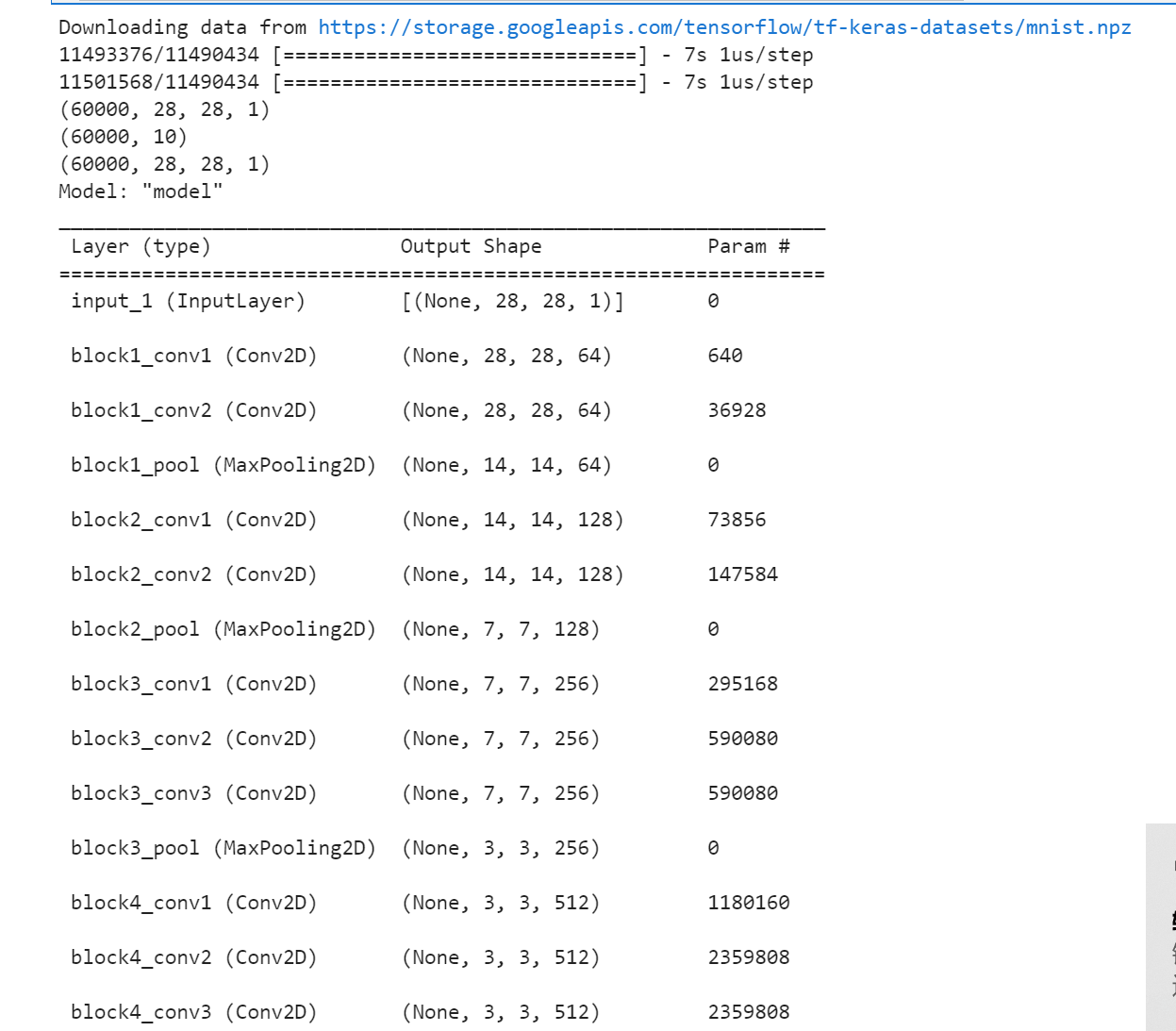
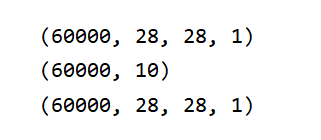

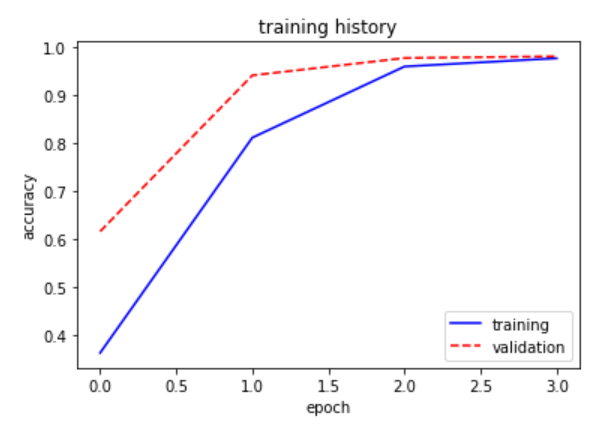
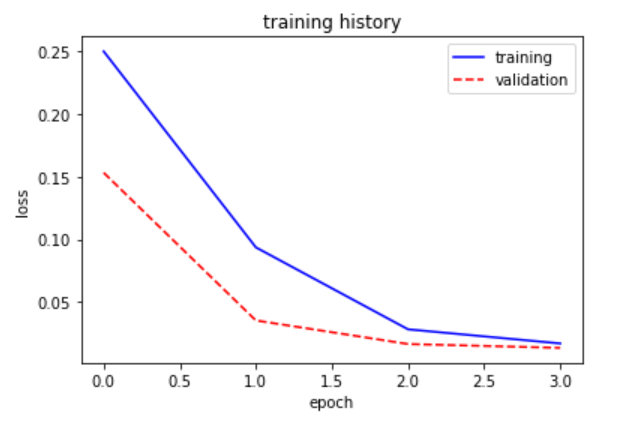
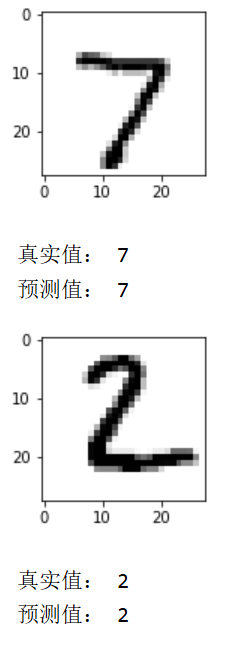
最新文章
- 高通AR和友盟SDK的AndroidManifest.xml合并
- virtualbox搭建ubuntu server nginx+mysql+tomcat web服务器1 (未完待续)
- CSS样式基础二
- GDUFE-OJ 1361校庆抽奖 翻转
- Linux终端杀手、程序员利器-Tmux
- 【BZOJ-3343】教主的魔法 分块
- Selenium2学习-003-WebUI自动化实战实例-001-百度搜索
- AMAB interconnector PL301(二)
- c# 关键字delegate、event(委托与事件)[MSDN原文摘录][1]
- ios UI实现技巧
- HD2086A1 = ?
- ZOJ 2110 Tempter of the Bone(DFS)
- CentOS开发环境LAMP搭建
- IT该忍者神龟Instant client required
- HUST 1339 Reversal(字符串)
- mysql中enum类型理解
- REST API disable / enable service auto start by API
- Excel—数学函数
- P1081 开车旅行(Not Finish)
- 血红蛋白值的临床意义(hemoglobin ,Hb,HGB)